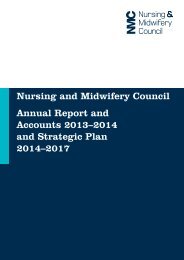Journal_1_2014_final_WEB
Journal_1_2014_final_WEB
Journal_1_2014_final_WEB
You also want an ePaper? Increase the reach of your titles
YUMPU automatically turns print PDFs into web optimized ePapers that Google loves.
tect the skin from damage. We reviewed studies that compared<br />
topical agents or dressings with other methods for preventing<br />
pressure ulcers. We found nine trials that investigated these that<br />
included 1501 people. These showed that the evidence concerning<br />
the use of topical agents or dressings for preventing pressure<br />
ulcers is not clear. The reason why the evidence is not clear is<br />
because the quality of trials was low and most had manufacturer<br />
sponsorship, which introduces potential biases, such as overestimating<br />
the effectiveness of the product. Consequently, further<br />
trials are needed to confirm results of this review.<br />
Publication in The Cochrane Library Issue 9, 2013<br />
Early versus delayed dressing removal after<br />
primary closure of clean and clean- contaminated<br />
surgical wounds<br />
Clare D Toon, Rajarajan Ramamoorthy, Brian R Davidson,<br />
Kurinchi Selvan Gurusamy<br />
Toon CD, Ramamoorthy R, Davidson BR, Gurusamy KS. Early<br />
versus delayed dressing removal after primary closure of clean<br />
and clean-contaminated surgical wounds. Cochrane Database<br />
of Systematic Reviews 2013, Issue 9. Art. No.: CD010259. DOI:<br />
10.1002/14651858.CD010259.pub2.<br />
Copyright © 2013 The Cochrane Collaboration. Published by<br />
John Wiley & Sons, Ltd.<br />
ABSTRACT<br />
Background: Most surgical procedures involve a cut in the skin<br />
that allows the surgeon to gain access to the deeper tissues or<br />
organs. Most surgical wounds are closed fully at the end of the<br />
procedure (primary closure). The surgeon covers the closed surgical<br />
wound with either a dressing or adhesive tape. The dressing<br />
can act as a physical barrier to protect the wound until the<br />
continuity of the skin is restored (within about 48 hours) and to<br />
absorb exudate from the wound, keeping it dry and clean, and<br />
preventing bacterial contamination from the external environment.<br />
Some studies have found that the moist environment<br />
created by some dressings accelerates wound healing, although<br />
others believe that the moist environment can be a disadvantage,<br />
as excessive exudate can cause maceration (softening and<br />
deterioration) of the wound and the surrounding healthy tissue.<br />
The utility of dressing surgical wounds beyond 48 hours of<br />
surgery is, therefore, controversial.<br />
Objectives: To evaluate the benefits and risks of removing a<br />
dressing covering a closed surgical incision site within 48 hours<br />
permanently (early dressing removal) or beyond 48 hours of<br />
surgery permanently with interim dressing changes allowed<br />
(delayed dressing removal), on surgical site infection.<br />
Search methods: In July 2013 we searched the following electronic<br />
databases: The Cochrane Wounds Group Specialised<br />
Register; The Cochrane Central Register of Controlled Trials<br />
(CENTRAL) (The Cochrane Library); Database of ABSTRACTs of<br />
Reviews of Effects (DARE) (The Cochrane Library); Ovid MED-<br />
LINE; Ovid MEDLINE (In-Process & Other Non-Indexed Citations);<br />
Ovid EMBASE; and EBSCO CINAHL. We also searched<br />
the references of included trials to identify further potentiallyrelevant<br />
trials.<br />
Selection criteria: Two review authors independently identified<br />
studies for inclusion. We included all randomised clinical trials<br />
(RCTs) conducted with people of any age and sex, undergoing a<br />
surgical procedure, who had their wound closed and a dressing<br />
applied. We included only trials that compared early versus<br />
delayed dressing removal. We excluded trials that included people<br />
with contaminated or dirty wounds. We also excluded quasirandomised<br />
studies, and other study designs.<br />
Data collection and analysis: Two review authors independently<br />
extracted data on the characteristics of the trial participants, risk<br />
of bias in the trials and outcomes for each trial. We calculated<br />
risk ratios (RR) with 95% confidence intervals (CI) for binary outcomes<br />
and mean difference (MD) with 95% CI for continuous<br />
outcomes. We used RevMan 5 software to perform these calculations.<br />
Main results: Four trials were identified for inclusion in this<br />
review. All the trials were at high risk of bias. Three trials provided<br />
information for this review. Overall, this review included<br />
280 people undergoing planned surgery. Participants were randomised<br />
to early dressing removal (removal of the wound dressing<br />
within the 48 hours following surgery) (n = 140) or delayed<br />
dressing removal (continued dressing of the wound beyond 48<br />
hours) (n = 140) in the three trials. There were no statistically<br />
significant differences between the early dressing removal group<br />
and delayed dressing removal group in the proportion of people<br />
who developed superficial surgical site infection within 30 days<br />
(RR 0.64; 95% CI 0.32 to 1.28), superficial wound dehiscence<br />
within 30 days (RR 2.00; 95% CI 0.19 to 21.16) or serious<br />
adverse events within 30 days (RR 0.83; 95% CI 0.28 to 2.51).<br />
No deep wound infection or deep wound dehiscence occurred in<br />
any of the participants in the trials that reported this outcome.<br />
None of the trials reported quality of life. The hospital stay was<br />
significantly shorter (MD -2.00 days; 95% CI -2.82 to -1.18) and<br />
the total cost of treatment significantly less (MD EUR -36.00;<br />
95% CI -59.81 to -12.19) in the early dressing removal group<br />
than in the delayed dressing removal group in the only trial that<br />
reported these outcomes.<br />
Authors’ conclusions: The early removal of dressings from clean<br />
or clean contaminated surgical wounds appears to have no detrimental<br />
effect on outcomes. However, it should be noted that<br />
the point estimate supporting this statement is based on very low<br />
quality evidence from three small randomised controlled trials,<br />
and the confidence intervals around this estimate were wide.<br />
Early dressing removal may result in a significantly shorter hospital<br />
stay, and significantly reduced costs, than covering the surgical<br />
wound with wound dressings beyond the first 48 hours after<br />
surgery, according to very low quality evidence from one small<br />
randomised controlled trial. Further randomised controlled trials<br />
of low risk of bias are necessary to investigate whether dressings<br />
are necessary after 48 hours in different types of surgery and levels<br />
of contamination and investigate whether antibiotic therapy<br />
influences the outcome<br />
Plain language summary:<br />
Early versus delayed dressing removal for people with<br />
surgical wounds<br />
Most surgical procedures involve a cut in the skin that allows the<br />
surgeon to gain access to the deeper tissues or organs. Most<br />
surgical wounds are closed fully at the end of the procedure.The<br />
surgeon covers the closed surgical wound with either a dressing<br />
72<br />
EWMA <strong>Journal</strong> <strong>2014</strong> vol 14 no 1




